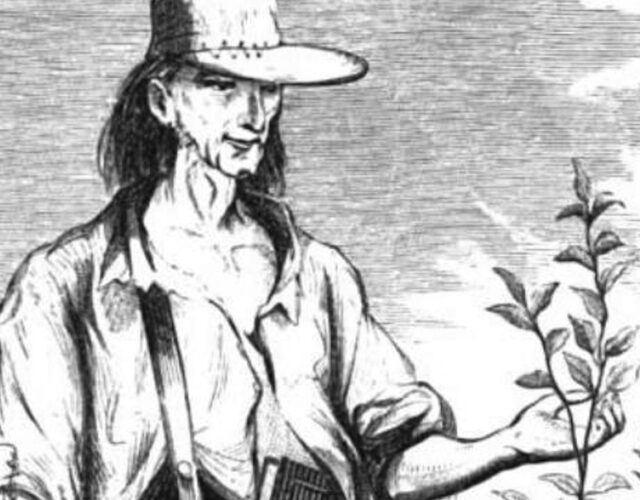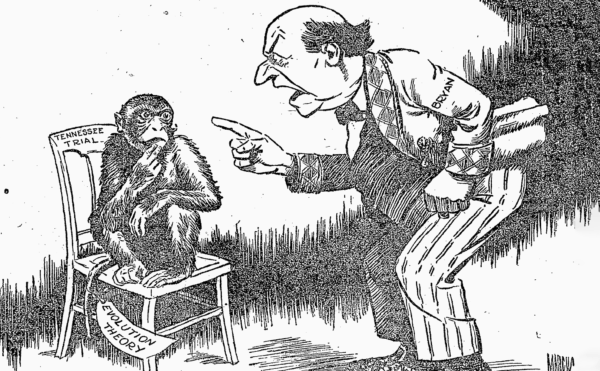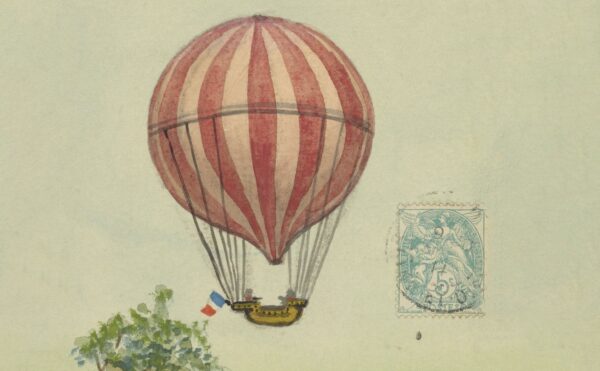Today we think of Johnny Appleseed as a kindhearted fellow who spent his life wandering the forest and planting apple seeds. But in this episode, Sam Kean points out that he was actually a shrewd businessman who provided people with the raw material to make cider.
About The Disappearing Spoon
The Science History Institute has teamed up with New York Times best-selling author Sam Kean to bring a second history of science podcast to our listeners. The Disappearing Spoon tells little-known stories from our scientific past—from the shocking way the smallpox vaccine was transported around the world to why we don’t have a birth control pill for men. These topsy-turvy science tales, some of which have never made it into history books, are surprisingly powerful and insightful.
Credits
Host: Sam Kean
Senior Producer: Mariel Carr
Producer: Rigoberto Hernandez
Associate Producer: Padmini Raghunath
Audio Engineer: Jonathan Pfeffer
Transcript
Remember the first time you heard about Johnny Appleseed? I do. The Disney cartoon. I learned all about this humble, kindhearted fellow who spent his life doing what he loved: wandering the forests and planting apple trees. All so people could have fresh, nutritious fruit and bake scrumptious pies. What a tale.
I was so inspired that I ran right out and snatched an apple off the tree in my parents’ backyard. It didn’t look like a Disney apple. It was small and dark green and knobby. A mean sucker. But I was too high on Johnny Appleseed to care. I took as big a bite as my missing front teeth allowed. <BITE>
<SPIT> And spit it out immediately. I then spent ten minutes scraping that awful taste off my tongue. To quote Thoreau, that apple was “sour enough to set a squirrel’s teeth on edge and make a [blue]jay scream.”
I still recall my disappointment. But, looking back, it makes sense. Because if you know a little bit about the DNA of apples, the odds of me getting a spitter like that were almost inevitable. Apples are a bizarre species biologically.
And that wasn’t the end of my disappointment. I soon learned that the Disney version of Johnny Appleseed was complete baloney.
He’s often revered as the patron saint of the American wilderness—our St. Francis. But to early Americans, the apple was not a symbol of wholesome living. It was a symbol of debauchery. Because the real legacy of Johnny Appleseed—what made him a legend—was not the fruit he delivered to farmers and ranchers. It was the booze.
<INTRO>
John Chapman—the future Johnny Appleseed—was born in Massachusetts in 1774. But he felt stifled in the crowded northeast. So in his early 20s he lit out for the Northwest Territory, land that’s now Ohio through Minnesota.
This once-Native land had recently been taken over by the United States, who eagerly filled it with settlers. Most settlers were outdoorsman, and there were plenty of curmudgeons and eccentrics among them. But even among those misfits, Johnny Appleseed stood out as a complete weirdo.
The first thing you noticed was his clothes. Instead of shirts and trousers he sometimes wore a ragged burlap sack. Like a frontier toga. He also wore a cooking pot on his head as a hat. If you saw him today, you’d cross the street to avoid him.
Johnny never had a fixed address his whole adult life, not even a crude cabin. Sometimes he slept in hollow tree stumps. Other times he slung hammocks between trees. One time, needing to travel downriver during the winter, he hacked out an icefloe, pushed off from shore, and snoozed away while floating on that.
Unlike most outdoorsmen, who hunted avidly, Johnny was a committed vegetarian and animal lover. There’s one story of him stepping on a worm and getting so distraught that he threw the offending shoe away and forced himself to walk barefoot as punishment.
Before long, he was going barefoot all the time, no matter the weather. He eventually developed feet so gnarly they looked like rhinoceros hides—grey and scaly and tough. He used to leave children wide-eyed by pressing hot coals into his soles, or jabbing them with needles. Didn’t hurt at all, he claimed.
On rare occasions, Johnny took advantage of someone’s hospitality and slept indoors in their cabin. But he quickly wore out his welcome by preaching incessantly. It was God this, heaven that. It sounded vaguely Christian, but was peppered with mystical mumbo-jumbo about spirits and nature. Most people just scratched their heads. But Johnny believed every word.
Now, based on what I’ve said so far—his weird clothing, his rootlessness, his mysticism—what I’m going to say next probably sounds farfetched. But, beyond all the other things Johnny Appleseed was, he was also, deep down, a shrewd entrepreneur.
His hustle was real estate. Back then, American settlers were quickly colonizing the Northwest Territory, greedy for farmland. So Johnny would study a map and use his experience in the backwoods to predict where people would flock next—the up-and-coming real-estate spots.
And a few years before everyone else headed to those spots, he’d go himself to plant apple trees. He transported the seeds in canoes, covered by damp moss to keep them moist. A single bushel basket held 300,000 seeds.
Upon arriving, he’d purchase some land, or else squat somewhere. Then he’d scatter seeds—not randomly, à la Disney, but in neat rows. At one time, he might have a dozen such nurseries going at different sites. Then he sat back and waited for settlers to arrive.
And arrive they did—he had a real nose for predicting the next big thing. At which point, Johnny sold them his saplings for 6.5 cents each. Given that the trees cost him nothing to grow, and that he’d sell them by the thousands, he always turned a fat profit. The American St. Francis was also a real-estate mogul.
People bought the trees for various reasons. Like making windbreaks on farms. But one reason they did not buy apple trees was to eat the fruit. Because believe it or not, most wild apples make for terrible eating.
Scientists now understand why. In short, apples have extreme genetic variability. That is, apples reshuffle their DNA like crazy every generation.
You can see this crazy variability in the original homeland of apples—Kazakhstan <“KAA-zuhk-ston”> in central Asia, where there are whole forests of apple trees. And the variety among those trees is astounding.
All the trees there are the same species. But some apples look like olives. Some look like cherries. Some like ping-pong balls. Some aren’t balls at all—they’re pointy cones. Some are snappy like raw potatoes. Some are mealy like corn bread. Some are leathery.
That variety extends to taste as well. Some taste like pears. Some like lemons. Some like nuts. Some are actually spicy.
So, yeah, there’s dizzying variety. Apples reshuffle their genes like this mostly as a defense against pests. The variation in shape and taste is a byproduct of that. But it does make it hard to grow good apples. If you take an apple seed and plant it, you pretty much have no idea what’s going to grow. It’s just a random throw of the dice.
Now, sometimes that genetic dice throw will make a good, tasty apple. It’s similar to how, if you rolled a dozen dice, every once in a while you’d get all sixes. Sometimes you do get lucky. But much more often, that random throw of the dice will produce a crappy apple. A spitter. <SPIT>
And again, that happens even from parents to offspring. A beautiful, tart, golden apple-parent could lead to a shriveled, mealy, bitter, red apple-child. Throughout nature, children never resemble their parents exactly. But apples take that to an extreme degree. In scientific terms, this variability is called heterozygosity. In colloquial terms, farmers say that apples don’t “come true.”
Now, some of you are probably saying, Wait a second. When I go to the grocery store, there are whole bins of uniform apples. And they’re uniform year after year. So what gives? If apples really don’t come true—if they really are variable each generation—how come we get such uniform apples every year?
Well, there’s a reason for that. Albeit an uncomfortable reason. Because all those apples you see in the grocery store—they’re all genetic clones.
<AD BREAK>
Yes, the dirty secret of apple-breeding is that all the apples in a grocery store are clones. Every Fuji, every Granny Smith, every Macintosh. All clones.
Now, I know what you’re thinking. Clones? Aren’t clones evil? Well, no. Identical twins are clones, and they’re not evil. I mean, yes, there were those creepy twins from The Shining. <CLIP> But generally speaking, twins are not evil.
Scientifically, being a clone just means you have the same DNA. So with apples, any Fuji you pick up in the store will have the same DNA as all the other Fujis. Same with Granny Smiths or Macintoshes or whatever: any one of them has the same DNA as all the others of that variety. Remember that next time you wander through the fruit section of the store. You’re surrounded by clones.
But those clones were not created in a lab. Instead, farmers use a technique called grafting. To see how this works, let’s take Baldwin apples as an example.
Long ago, one lucky tree rolled the genetic dice perfectly and came up with the Baldwin—a real winner. But the farmer knew that if he planted the Baldwin seeds, he’d almost certainly get a spitter. So he took a twig from the special Baldwin tree <SNAP> and carved a notch into another, not-so-special apple tree. Then he wedged the twig into that notch.
Eventually, the twig fused onto the new tree. Later, it started producing Baldwin fruits of its own. And voilà—he’d cloned fruit from one tree to another. After repeating that a thousand times, he had an orchard of clones. And he didn’t need a lab to do it.
Now, notice that this technique would not work with animals. If you grafted a tasty hunk from one cow onto a second cow, the second cow would not turn into a Frankencow with cloned meat flanks. It would reject the transplant. But plants are different. You can graft and fuse them, and produce all the clones you want.
At this point, finally, we can circle back to Johnny Appleseed.
Again, apples don’t come true. So if the parents have tasty fruit, the offspring might have bitter, terrible fruit. So in planting mounds of apple seeds, Johnny was growing thousands of trees with spitters and selling them to people. Was he just a huckster? Ripping people off?
No. People back then didn’t care about sourness or bitterness, because they had no intention of eating apples. They were using them to make booze.
Making booze from apples was shockingly easy. First, you gathered your spitters and let them get mushy. Then, you put them in a press and squeezed out the juice. If you left that juice in buckets, wild yeast would ferment it. Before long, you’d have hard cider, roughly half as strong as wine.
Farmers produced even stronger liquor by leaving it outside in the winter to freeze. Cider contains both water and alcohol. Below 32 degrees, the water freezes into ice. Alcohol, meanwhile, freezes at far lower temperatures.
So after a bitterly cold night, the cider in the bucket separated into two phases. An ice phase, which was mostly water. And a liquid phase, mostly alcohol. Chip away the ice, and voilà—concentrated liquor. People called it applejack. It could reach 66 proof—packing quite a punch.
Overall, then, that’s why farmers eagerly bought Johnny Appleseed’s trees. To make liquor. As others have pointed out, Johnny Appleseed was less an American St. Francis, and more an American Dionysius <“di-oh-NYE-see-uss”>, the Greek god of wine.
So then how did this liquor pusher get transformed into a Disney folk hero? And moreover, how did apples themselves transform into a symbol for wholesome living? In a word, Prohibition.
As stupid as Prohibition was, Americans did drink staggering amounts of liquor in the 1800s. Adults averaged—averaged—90 bottles of 80-proof liquor every year. That’s 1.7 bottles per week. Even children drank hard cider. And it wasn’t just ruffians. John Adams guzzled a glass of cider every morning. James Madison polished off a pint of whiskey daily.
Given all this imbibing, Prohibitionists saw apples as part of the problem. Apples enabled liquor, and apple were therefore evil—akin to the apple in the garden of Eden, or the poisoned apple of Snow White.
So when Prohibition finally took hold, and liquor production stopped, U.S. apple orchards faced a crisis. How would they make money now?
The answer was to rebrand apples. To make them seem heathy and nutritious. The whole thing about an apple a day keeping the doctor away—it was a marketing slogan.
But, for the marketing to succeed, apples suddenly had to taste good. No more spitters. So orchard owners started scouring their trees for any halfway tasty variety.
This search for tasty apples intensified after a few varieties took off, and made their owners millions. It was a botanical Gold Rush. And as more and more winners emerged, and began to fill the shelves of grocery stores, the rebranding took hold. A new generation arose who thought of apples not as potential liquor but as wholesome snacks. Overall, then, our view of apples today is a weird combination of marketing ploys and get-rich-quick schemes—two things that are as American as, well, apple pie.
Now, I did this Johnny Appleseed story today because it’s October, and apples are a fall fruit. But there are other notable fall fruits with some fascinating science behind them as well. Like giant pumpkins. So I’ve put together a bonus episode at patreon.com/disappearingspoon.
Some giant pumpkins weigh as much as automobiles and are big enough for Cinderella’s carriage. Really. And while I can’t vouch for the accuracy of this, I did hear one story about a pumpkin so big that, when someone took a photograph of it, the picture alone weighed seven pounds. All that and more, at patreon.com/disappearingspoon.
I’ll finish the apple story with this. Beyond the booze and the get-rich-quick schemes, apples appealed to Americans for another reason. Americans like to think of ourselves as rugged individualists, and in the 1800s apples played nicely into that idea. Unlike many crops, the trees didn’t need special care. No plowing, no weeding, no coddling. You just let them go, and they flourished. Rugged individuals.
Lately, though, things are different. I hope I’ve disabused you of the idea that clones are evil. But that’s not to say that clones are always good. Especially in agriculture.
In terms of evolution, there’s a reason wild apples show extreme variability. Because variability helps them keep ahead of pests. By reshuffling their genes over and over, apples develop new defense systems that make it hard for pests to kill them. Because even if a pest evades all the natural defenses of one wild apple, it cannot kill the next tree over, because that tree is so genetically different.
At least, that’s the way things used to be. Apples in orchards nowadays are mostly clones—genetically identical. So if a pest unlocks a way to destroy the fruit of one apple variety, it can now destroy every single identical apple in the orchard.
In other words, while apples are now genetically frozen, bugs and fungi keep evolving. And over the decades, they’ve gotten very good at destroying apples.
As a result, apples now require tons of pesticides, or else they’d get wiped out. Back in Johnny Appleseed’s day, these trees were considered rugged individualists. Now, they’re weak conformists, entirely dependent on human intervention to live.
The technique for grafting trees did exist in Johnny Appleseed’s day; it’s old technology. But grafting didn’t jive with his mystical views of nature. He in fact called grafting “wicked,” and declared that “God only can improve the apple.”
Because to him, there was beauty in imperfect apples. Sure, you got some spitters. But wild apples were healthier and heartier overall. And if the imperfections got to be too much, well, there was a solution for that, too. Just alchemize them into booze and have a nice, long drink. After that, life’s imperfections didn’t seem so bad.




